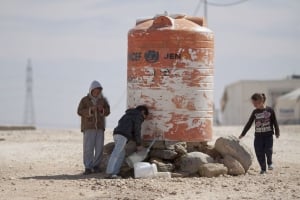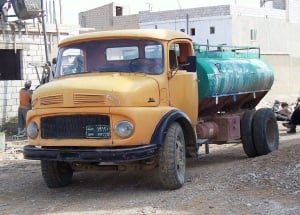High and Dry with the Hashemites
Keith Proctor
Last year, Mercy Corps, the international humanitarian agency, published Tapped Out: Water Scarcity and Refugee Pressures in Jordan. It was an attempt to come to terms with the challenges facing the Hashemite Kingdom. One year later, many of the dangerous trends we identified continue to persist.
With much of its land an arid, inhospitable desert, the Hashemite Kingdom of Jordan, one of the world’s driest countries, threatens to die of thirst.
Analysts have long warned that Jordan, saddled with shrinking renewable resources and a quickly growing population, faced a reckoning. In recent years, however, the challenges confronting this parched kingdom have accelerated.
The Syrian civil war is largely to blame. Since 2012, 622,000 Syrian refugees – equivalent to roughly a tenth of the kingdom’s pre-crisis population – have flooded into northern Jordan. Groundwater depletion has accelerated. Water tables are dropping precipitously. And as water levels decline, salinity rises, rendering what remains less and less drinkable. The water under Jordan is disappearing – and, perhaps with it, the stability that has made the country one of the Middle East’s most durable.
According to Marwan al-Muasher, the kingdom’s former deputy prime minister, “In the present environment, water scarcity is an existential threat to Jordan.”
Refugees, governance and conflict
The challenges of scarcity are particularly pronounced in the refugee-crowded north. In those communities hardest-hit by refugees, water demand quadrupled. Daily water supply dropped from above 80 liters per person to as low as 30 – less than a quarter of a bathtub, and well below the 50-liter standard deemed necessary to meet basic needs. At that level, sanitation standards decline, diseases rise, subsistence crops wither and children go thirsty. During dry months, weeks might elapse before a drop comes out of the tap.

When the water does not flow, it produces an environment ripe for scapegoating. A Mercy Corps assessment, completed last fall, found that resource scarcity is a persistent source of tension between Jordanians and Syrians. While hard feelings are mitigated to some extent by kinship – many refugees share blood ties with their hosts – and a “culture of hospitality,” Jordanian patience is wearing thin. Anger at refugees has fomented Jordanian protest movements like Hiraq Nashama al-Mafraq, and anti-Syrian rants by nationalist radio hosts, such as Mohammed al-Wakil and Mahmood al-Hoyan.
Just as troubling is Jordanians’ growing frustration with their government. Increasingly, anger over water scarcity is directed at Amman.
It is not hard to see why. The institutions responsible for providing water have been badly overwhelmed by spiking demand. Yarmouk Water Company (YWC) – the utility contractor responsible for many of the refugee-affected areas – is bloated, inefficient and plagued by severe resource constraints, according to an appraisal completed last year by IDRC, the research consultancy. The utility has proven unable to address service interruptions or pipeline breaks, prompting overwhelming volumes of complaints. These have risen with the refugees. According to YWC data, from 2011 to 2013 complaints nearly quadrupled: from 12,520 to 45,433. Most go unanswered.
The breakdown of vital public services is dangerously corrosive, and in the hot, dry summer months have sparked tumult: angry protests, attacks on pump stations, highways blocked by piles of burning tires. The government has managed the worst of it. So far.
Kicking the can down the road
Refugee pressures layer over long-standing challenges of scant supply, poor resource management, and out-of-date infrastructure. Jordanian water management has long been unsustainable. Rather than fix a badly ailing pipeline network, for instance, it was cheaper or easier to dig more wells, pump more water and invest in large-scale new efforts. According to research by Dr. Marwan Raggad, a hydrogeologist at the University of Jordan, years of over-pumping put the kingdom on schedule to exhaust underground fresh water as early as 2060.
Few doubt that after Syria’s bloody civil war pushed tens of thousands of families across the border, refugee pressures have sped up the clock.
In years past, according to Saeed Hameed, a water and sanitation specialist with UNICEF based in Amman, Jordan was able to keep pace with rising demand by leap-frogging from one large-scale investment to the next. But no more.
“The refugee crisis ruined the old strategy,” he said.
Wringing water from a dry sponge
Over the past year, the slide in water provision has been arrested, but at the cost of pumping more water, more quickly, out of Jordan’s precious northern aquifers.

There is no way to “fix” water scarcity. Geography, climate and demographics all conspire to add Jordan to the roster of the world’s most water insecure states. But wringing more water from a dry sponge is no strategy. With refugees not going home any time soon, future efforts must balance immediate needs against sustainability.
First, future investments should focus less on drilling wells and more on fixing a criminally decrepit pipeline network. Of all the water Jordan pumps out of the ground, billions of liters simply gush out of broken pipes. By one estimate, the amount of water lost nation-wide to aging infrastructure would, over a year, satisfy the basic needs of four million people. It is a tragedy of waste.
Second, institutional gaps need to be filled. Investing in infrastructure makes little sense if new projects are handed over to agencies that have neither the resources nor expertise to run and maintain them. YWC’s house is badly out of order: the utility needs not an infusion of capital, but an aggressive restructuring. Jordan’s southern utility companies, in Amman and Aqaba, deliver services more effectively and efficiently. Their know-how should be leveraged in the north.
Third, conflict mitigation is needed to reduce tensions between hosts and refugees, which have been on the rise. Mercy Corps’ research found that creating communal spaces for Syrians and Jordanians, combating stereotypes and supporting leaders with conflict mediation skills have worked to measurably reduce the propensity to violence.
Lastly, development actors must support community-based efforts to manage water demand through conservation education and improved local infrastructure. Rooftop rainwater catchments, household cisterns, greywater treatment systems: helping households, schools and hospitals finance these projects, through grants and revolving loans programs, have reduced household vulnerability and relieved pressure on centralized water systems.
While never welcome, crises are inflection points: they provide opportunities to transform attitudes and, in an environment of scarcity, promote sustainable innovations. Jordan and its international partners need to make the smart investments today. If they don’t, it will almost certainly be at the cost of a drier tomorrow.

